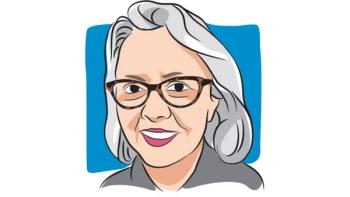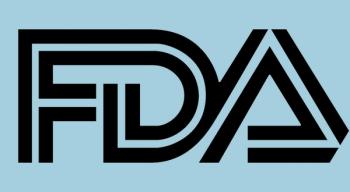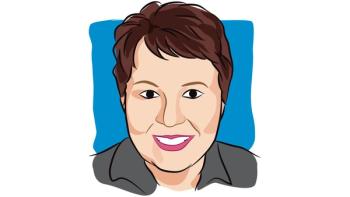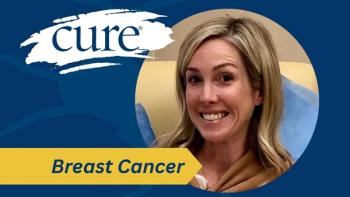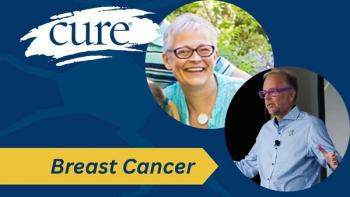
- Winter 2015
- Volume 14
- Issue 1
A Two-Way Street: Joan Lunden Shares Her Cancer Experience
Throughout her treatment for breast cancer, TV personality Joan Lunden has advocated for patients like herself—while drawing strength from their support.
Joan Lunden held onto something vital the day her father died.
After the plane crash that killed the prominent cancer surgeon, Lunden vowed she would carry on his mission to help people live healthy lives. She was 13 years old.
At first, Lunden thought she would accomplish that by becoming a doctor, but in the brief time she spent working in a hospital, she could tell that scalpels and stitches were not for her. Instead, she became a television newscaster, speaker and author, devoting much of her career to encouraging audiences to live a healthy lifestyle.
Now that the former star of ABC’s “Good Morning America” is a patient herself, she’s continuing that effort. Diagnosed with triple-negative breast cancer in June 2014, Lunden has undergone 16 rounds of chemotherapy, followed by a lumpectomy and radiation that concluded on Feb. 13. She’s working more from home, but she’s working, chronicling her treatment and sharing her new knowledge about cancer with an eager fan base via her website JoanLunden.com, social and print media, television interviews and speeches.
Joan Lunden was diagnosed with triple-negative breast cancer in the summer of 2014. Photo courtesy of JoanLunden.com.
As the keynote speaker Feb. 28 at the Miami Breast Cancer Conference—run by Physicians’ Education Resource, a sister company to CURE—she’ll address a ballroom full of doctors who do the same thing her father did. “I have the unique opportunity to give the patient’s perspective from my personal journey,” she says, “and be the voice for the thousands of women who have written in to me who are battling cancer as well.”
In an interview at her home, Lunden called that work the silver lining to an otherwise grueling and frightening experience.
“I was going to sleep one night and I said, ‘Nobody wants to get cancer. But in a kind of odd way, this is dropping into my lap an opportunity to fulfill my dad’s legacy.’”
ADVOCATING FOR ULTRASOUND
One way Lunden is doing that is by speaking frequently about the fact that she has dense breast tissue, which makes it hard for doctors to discern tumors via mammogram—even the new 3D kind. If she hadn’t followed her most recent mammogram with an ultrasound, Lunden says, she would have been in the dark about the aggressive 2.3-centimeter tumor in her right breast, near her chest wall, and the smaller one growing in front of that.
Dense breast tissue appears white on a mammogram—and so do tumors. “It’s basically like looking for a snowball in the middle of a snowstorm,” she says. Perhaps the biggest problem with dense breast tissue is that many women have no idea they have it, or that it can cloud the results of their mammograms.
Lunden knew she had dense breasts after being told often by screening professionals that her mammogram results were difficult to read. She learned more about the issue five years ago when she conducted an on-camera interview about mammograms with breast cancer surgeon Susan Love, of the Dr. Susan Love Research Foundation. Between takes, Love asked Lunden if she was getting screenings herself, and when Lunden mentioned having dense breasts, Love suggested that she speak to her doctor about having an ultrasound after every mammogram. The newer whole-breast, 3D ultrasounds are best, Love says now, because they are less susceptible to user error yet still emit no radiation.
It was because of that conversation that Lunden found her cancer when she did.
“Had I walked out of that radiology lab that day only having a mammogram,” Lunden says, “I would have gone about my merry way, saying ‘I’m fine,’ and I would have had a fast-growing, virulent, rare form of breast cancer growing in my right breast.”
Now, Lunden hopes to educate others the way Love educated her. In fact, according to a reader of her website who specializes in breast screening, Lunden has become “the face of women with dense breasts saved by ancillary imaging, and (of ) the need for notification of this condition.”
“One of my great passions is to make women more aware of their bodies, their breasts and the fact that they need to know whether or not they have dense breast tissue,” Lunden says. “And let me just say that you can’t tell by the way your breast looks or feels from the outside. But when you go to a radiology lab and you have a mammogram, you should find out.”
“I was going to sleep one night and I said, ‘Nobody wants to get cancer. But in a kind of odd way, this is dropping into my lap an opportunity to fulfill my dad’s legacy.’” —Joan Lunden
About 10 percent of women have extremely dense breast tissue, and that creates a mild to moderate risk for the development of breast cancer; however, the risk that these women will fail to detect a breast cancer that has already developed is much higher, says Patrick Borgen, chairman of the Department of Surgery at Maimonides Hospital in Brooklyn, N.Y., and chair of the Miami Breast Cancer Conference. While most women won’t benefit from getting more than a mammogram, additional imaging can be a good idea for women with dense breasts, especially if they are postmenopausal. Yet there is no standard screening strategy for these women. Ultrasound or MRI combined with mammography are being considered, but studies on effectiveness have yet to be conducted, and health insurers don’t always pay.
In some states, it’s the law that women are told about their dense breast tissue. Many states have passed legislation requiring doctors to tell their patients if their breasts are dense, and to discuss a post-mammogram ultrasound. According to advocacy group Are You Dense?, Inc., as of mid-January, 21 states had enacted such legislation. In July, Sen. Dianne Feinstein introduced legislation that would have made such laws a federal standard, but the Breast Density and Mammography Reporting Act died in committee. Feinstein and Sen. Kelly Ayotte reintroduced the measure Feb. 4.
The bottom line, Borgen says, is that women with dense breasts should talk to their gynecologists or radiologists about whether ultrasound after mammogram makes sense for them.
Lunden couldn’t agree more, and people seem to be hearing her message.
“In a Facebook message the other day, someone said, ‘Joan, thanks for saving my life. Because of listening to you, when I got my mammogram I asked them and found out that I had dense breast tissue. So I got an ultrasound and I found out that I had breast cancer. And my doctor told me that, had I not had that ultrasound, the tumor probably would not have shown up on a mammogram for at least 18 months to two years, if they would have ever been able to see it.’
“These Facebook messages, that’s what life’s all about,” Lunden continues. “To be able to feel like you helped touch another person’s life and helped them make a better informed decision about their health that saved their life—I mean, who could ask for anything more?”
TRYING SOMETHING NEW
Lunden has also been open about her selection of a newer medical regimen to treat her cancer. She hopes the information will encourage others to look beyond the status quo before settling on a treatment plan— and that includes both patients and the oncologists she’ll speak to in Miami.
Because Lunden had triple-negative breast cancer— meaning her disease wasn’t fueled by hormones or an overabundance of the HER2 gene—it was expected that chemotherapy, rather than a targeted treatment, would be most effective. Her treatment would also need to include surgery and radiation, she was told, but there were different ways the regimen could be approached.
The first oncologist Lunden saw encouraged her to have chemotherapy as an initial step in order to shrink her tumors and make her surgery less invasive, then follow the lumpectomy with radiation. And the doctor recommended adding carboplatin to the chemotherapy regimen, also a newer idea.
Chemotherapy for triple-negative breast cancer typically includes 12 weeks of Taxol (paclitaxel) followed by four cycles of doxorubicin plus cyclophosphamide. But Lunden’s oncologist cited a study presented at the San Antonio Breast Cancer Symposium in 2013, which had demonstrated that adding either carboplatin or Avastin (bevacizumab) to some of those cycles improved the pathologic complete response rate in patients by about 60 percent.
That sounded promising to Lunden, but when she sought a second opinion from a physician at a different renowned institution, she was advised to have her surgery before she received chemotherapy. The divergent opinions left Lunden and her husband baffled.
According to Borgen, “A number of trials have demonstrated the advantages of pre-surgical chemotherapy across a wide panorama of breast cancer, including triple- negative, and carboplatin is an accepted cytotoxic chemotherapy choice for triple-negative breast cancer. However, having chemotherapy first is a less common approach. Nationally, there is still resistance to deviating from the longstanding dogma of surgery, then chemo, then radiation. The benefits of pre-surgical chemotherapy, particularly in the type of breast cancer Joan Lunden had, are abundantly clear.”
In Lunden’s case, the chemotherapy eradicated her smaller tumor and shrank the bigger one by about 70 percent, resulting in a surgery she describes as minimal. Then, she received radiation five days a week for six weeks.
Although Lunden recognizes that patients’ treatment needs are quite individual, she’s sharing her own choice because she wants women to know that they have options. Her worry is that others in her shoes will be automatically steered toward the more typical therapeutic regimen without discussion.
Borgen anticipates that the 1,000 oncologists who hear her story in Miami will be receptive to Lunden’s point of view, especially because the purpose of the gathering is to foster awareness of state-of-the art treatments, as well as to promote a multidisciplinary approach that improves the care of patients with breast cancer. “It is so hard to stay current in breast cancer,” he says.
“It’s a field that changes week to week, month to month. The studies are very clear that giving chemo first is a path that should be strongly considered in this type of breast cancer. Switching the order, doing chemo before surgery, made (Lunden’s) surgery smaller, which proves that the sequence of treatments, and the chemo combination, were the right choices for her. But if this regimen doesn’t work in another patient, an option is to simply change the drugs in the chemo combination. There is still resistance from some oncologists and surgeons to this approach.”
Still, Borgen says, things are moving in the right direction when it comes to treating women with breast cancer.
“I’ve done this for over 25 years. I’ve treated nearly 6,000 women with breast cancer. And our success rates and our victories are exponentially different than they were in the 1990s or in the mid-2000s,” he says. “There are 200-plus drugs in the breast cancer pipeline going through FDA testing. Genomic profiling, opening up the hood on these cancers and looking at the genes that are driving them, looking at the signaling pathways that are involved, allows us to precisely personalize our treatment approaches to this large, complex family of diseases. It’s impossible for me to be pessimistic about breast cancer today.”
MOVING IN THE RIGHT DIRECTION
Things seem to be moving in the right direction for Lunden, as well.
While she remained tired in mid-January from chemotherapy and radiation, she saw her blood counts slowly improving; she expects to find out in June whether there’s any evidence of cancer left in her body. “You start to feel a little bit better every day, and some of the side effects start to wane,” she says. “I can see the finish line, and that’s important.”
Joan Lunden reading letters while receiving treatment. Photo courtesy of JoanLunden.com.
Cancer has changed Lunden in a variety of ways. Down to some of the smallest details, her work reflects the disease’s presence in her life. She has a section about breast cancer on her website, in which she shares a video blog of herself undergoing treatment, but related issues have made their way into the other sections, too—including a video of Lunden explaining how to style a wig. Lunden’s three adult daughters also share advice based on their experience with their mother’s cancer journey.
Not surprisingly, cancer has changed Lunden personally, too.
“You can’t dance with death and look at it in the mirror and not change,” says the mother of seven, including two sets of twins. “You become more appreciative of life, of your friends, of your family, of your home, of your ability to do things.”
Cancer also teaches you to pace yourself. Lunden did that, but only at her doctor’s insistence. It happened after Lunden, whose white and red blood-cell counts were very low, claimed to be feeling great.
“I’m not sure that you actually have the ability to recognize when you’re tired, because you’re so used to pushing through it,” the doctor told her.
She asked Lunden not to exercise for a week so she could learn to listen to her body’s signals. More frustrating, though, was that the warning didn’t just apply to working out—it applied to working. Lunden was not to fly anywhere until her compromised immune system bounced back.
“Having to cancel some of the speeches that I was already booked for in the fall was one of the hardest things I’ve ever done,” says Lunden, who anticipates a return to her regular level of activity this year, and has already booked a full calendar. “I felt I was letting people down. But you just have to understand that your number-one priority has to be fighting the cancer and making sure that you don’t put yourself at any kind of health risk during this really aggressive form of chemotherapy.”
Her fans understand, and they’ve let her know.
In posts to her website, many compare notes with Lunden about treatments and side effects, thank her for sharing the details of her cancer experience and wish her well.
“Keep up that positive outlook,” one woman wrote. “Your life’s resumé now includes cancer survivor, and by continuing to share your story, you will be more prepared for those crazy mind games cancer continues to play on you. Congratulations on a job well done. You are getting the message out about cancer coming in all forms and each journey being different. Carry on!”
Such messages have helped Lunden cope at difficult moments.
“The fact that these people take the time every day to just write a little message back or pray for me, tell me to stay strong, or share their tips or advice has been a very big part of my healing,” she says, “and is just keeping me strong.”
“It was very confusing, and ultimately I had to go with my gut. It was really scary and part of the frustration and angst that cancer patients experience,” Lunden says. Ultimately, she chose the newer regimen as “the one that would give me my best chances for success and my best chances to not have a reoccurrence of the disease.”
Articles in this issue
over 10 years ago
Pipelineover 10 years ago
CancerFilms.orgover 10 years ago
Council Would Accelerate Development of Prostate Cancer Diagnosticsover 10 years ago
Research Updates from ASH & SABCSover 10 years ago
Camp Kesem for Kidsover 10 years ago
When Your Life Is Touched by Cancerover 10 years ago
Help With the Costs of Targeted Drugs
